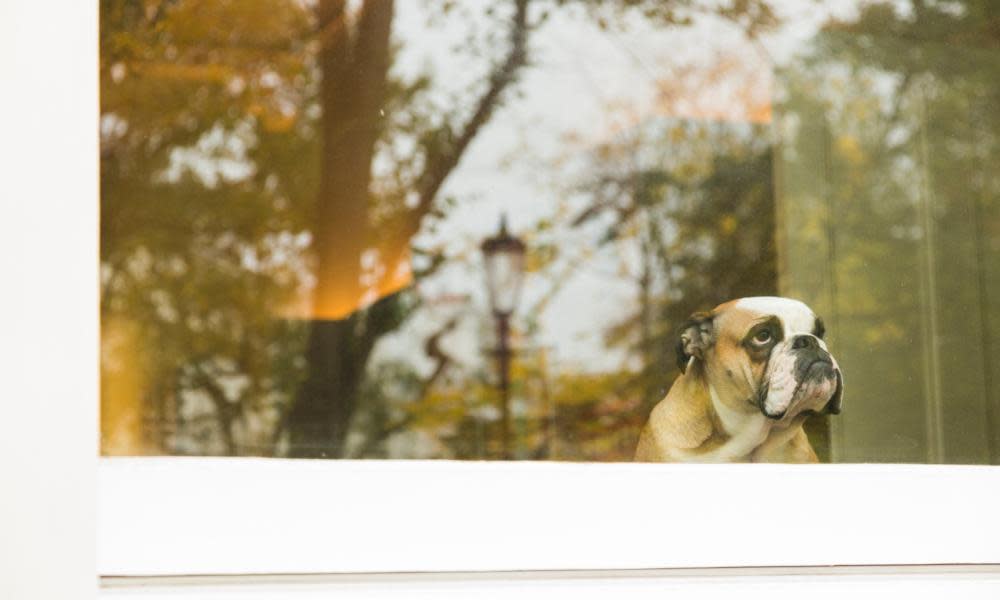Sit! Stay! Don’t be sad! How to protect your pet from separation anxiety

Like an apocryphal butterfly flapping its wings and unleashing untold chaos thousands of miles away, one miscreant virus particle is all it took to alter the human-pet dynamic across the globe.
In this lockdown era, many animals initially thrived, like my own cat, Junior. Although he had always known me as a commuter who frequently spent nights away from home, he took to my newfound permanence like a duckling following its mother to water. He loved it so much that, when restrictions eased after the first lockdown last summer, he developed a suite of anxiety-related behaviours.
When I wasn’t here, he scratched at windows and meowed at the front door. When I was, he lay on keyboards and interrupted Zooms. In our lowest moments together, to nullify the soundtrack of scratching and yowling at the locked door, I had to let him join me every time I used the toilet. There were others in the house, but they rarely got the same treatment. Perhaps my status as feeder-in-chief had created a deeper bond.
Junior was but one of millions of animals with post-lockdown blues – a so-called “separation distress” caused by our no longer being confined to the indoors, nice and warm and predictable, nearby. You may have heard a little about this – but it’s usually in connection with dogs. Talking to other cat owners, I discovered that Junior’s behaviour was not that unusual. Sure, many laughed outright at the idea of cats being emotionally dependent upon us (to quote Terry Pratchett: “In ancient times cats were worshipped as gods; they have not forgotten this”), but others referred to the tell-tale scratching at the window pane as they left home. One cat-sitter, a veteran of five years, mentioned regularly breaking out the pet-friendly essential oils to restore the contentment she had seen in yesteryear.
What could I have done to limit Junior’s distress during this time? More generally, what can pet-owners do to prepare their pets for the coming days without them?
As far as dogs go, Rachel Casey of Dogs Trust advises owners to start the preparations now. “It’s easy to do,” she explained in a recent Guardian article. “Start building up experiences of all the things we will expect them to do once the lockdown eases. For instance, start building in minimal periods apart, initially just being briefly separated from you by a door or child gate.”
Could such an approach work on anxious cats, too?
“I’d say the same rules apply as with dogs – start to prepare them for the routine-change in advance if you can,” says Naomi Harvey, a specialist in pet behaviour. “Build in some separations, leaving them with something tasty to forage for so they get something positive when you go. Scattering food for them to ‘hunt’ down or filling up a puzzle feeder are great ideas.”
Other species might also benefit from a watchful eye in the months to come. Parrots are prone to go on hunger strikes and pull out their feathers when left alone without their human companions. Rabbits can also exhibit distress at separation. As with dogs, symptoms include destructive behaviours such as chewing on slippers and carpets and reverting to unsavoury toilet habits.
In many cases the remedy is broadly the same: a softly, softly approach to separation, building up steadily each day. If obvious agitation rears its head again, you’re going too fast – slow down, start again.
The benefits to successfully avoiding prolonged distress are worth reiterating. Good preparation for post-lockdown separation limits the emotional suffering of pets and reduces the likelihood that your pet ends up needing to be re-homed. And separation distress is about more than just emotional damage: prolonged stress is bad for pets in a variety of other ways.
According to Niki Khan, a reproductive ecologist at Nottingham Trent University, stress can impact fertility in pets; stressed pets also become ill more often and take longer to recover from illness or injuries.
“What we see in a lot of animals, including humans, is reduced growth, loss of appetite or cravings for high-fat, high-glucose foods to replace the energy we’re using while stressed, and difficulty digesting food, difficulty concentrating, as well as the more typical anxiety-related behaviours to try to self-comfort or as a result of nervous energy,” Khan says.
Though Junior’s curious behaviour disappeared in time, I feel a little stupid for not immediately understanding what was behind it. It seems so obvious now – but this was the first lockdown of several and we were all learning.
Let’s all try to be a little more prepared as we come out of the third. And leave the toilet door mercifully ajar, for as long as is needed.

 Yahoo Movies
Yahoo Movies 
